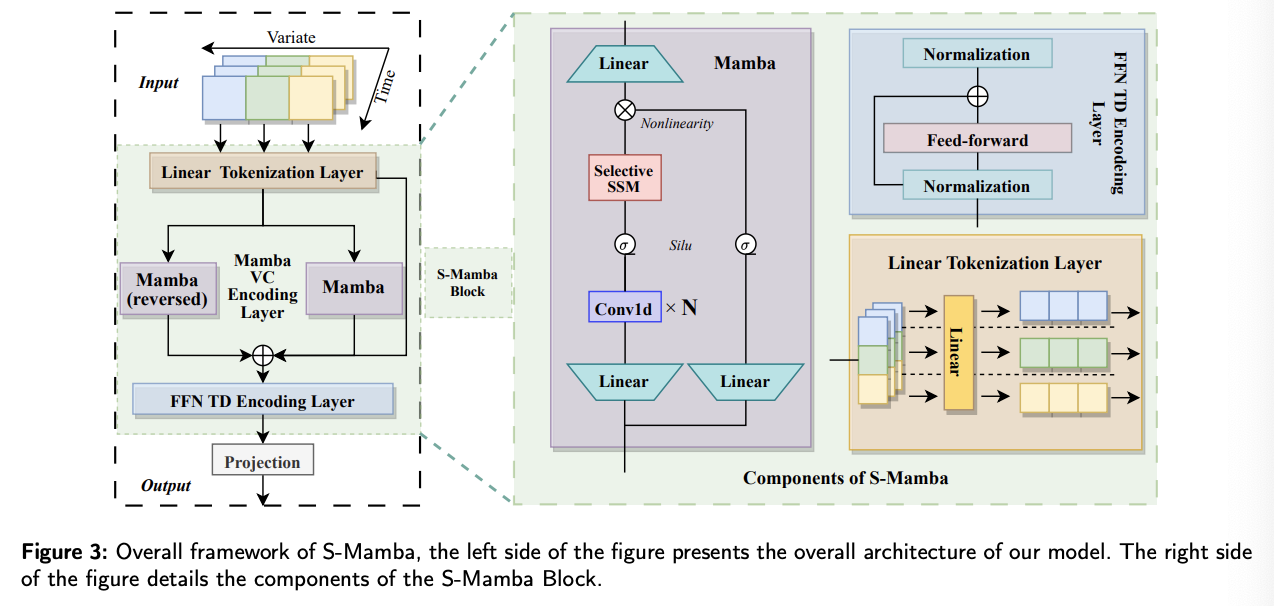Is Mamba Effective for Time Series Forecasting?
Contents
- Abstract
0. Abstract
Limitation of Transformer: Quadratic complexity
Solution: Mamba: Selective SSM
S-Mamba
- Simple-Mamba (S-Mamba) for TSF
- Details
- (1) Tokenization: Tokenize the time points of each variate via a linear layer
- (2) Encoder:
- 2-1) “Bidirectional” Mamba layer: to extract inter-variate correlations
- 2-2) FFN: to learn temporal dependencies
- (3) Decoder: linear mapping layer.
https://github.com/wzhwzhwzh0921/S-D-Mamba.
1. Introduction

- TD: temporal dependency (intra-series)
- VC: inter-variate corrrelation (inter-series)
S-Mamba (Simple-Mamba)
- Step 1) Linear layer
- Time points of “each variate” are tokenized
- Step 2) Mamba VC (Inter-variate Correlation) Encoding layer
- Encodes the “VC” by utilizing a “Bidirectional” Mamba
- Step 3) FFN TD (Temporal Dependency) Encoding Layer
- Extract the “TD” by simple FFN
- Step 4) Mapping layer
- Output the forecast results.
Experiments
- Low requirements in GPU memory usage and training time
- Maintains superior performance compared to the SOTA models in TSF
Contributions
(1) Propose S-Mamba
-
Mamba-based model for TSF
-
Delegates the extraction of
- (1) [VC] inter-variate correlations
- (2) [TD] temporal dependencies
to a bidirectional Mamba block and a FFN
(2) Experiments
- vs. SOTA models in TSF
- Superior forecast performance & Less computational resources
(3) Extensive experiments
2. Related Works
(1) TSF
a) Transformer-based
pass
b) Linear models
pass
(2) Application of Mamba
a) NLP
b) CV
c) Others
Tasks of predicting sequences of
- sensor data [6]
- stock prediction [50]
Sequence Reordering Mamba [60]
- Exploit the inherent valuable information embedded within the long sequences
TimeMachine
- Capture long-term dependencies in MTS
Effectively reduce the parameter size & improve the efficiency of model inference
( while achieving similar or outperforming performance )
3. Preliminaries
(1) Problem Statement
- Input: \(U_{\text {in }}=\left[u_1, u_2, \ldots, u_L\right] \in \mathbb{R}^{L \times V}\)
- \(u_n=\left[p_1, p_2, \ldots, p_V\right]\).
- Output: \(U_{\text {out }}=\left[u_{L+1}, u_{L+2}, \ldots, u_{L+T}\right] \in\) \(\mathbb{R}^{T \times V}\).
- \(p\) : Variate
- \(V\) : Total number of variates
(2) SSM
Concepts
- Latent states \(h(t) \in \mathbb{R}^N\)
- Output sequences \(y(t) \in \mathbb{R}^N\)
- Input sequences \(x(t) \in \mathbb{R}^D\)
\(\begin{aligned} h(t)^{\prime} & =\boldsymbol{A} h(t)+\boldsymbol{B} x(t), \\ y(t) & =\boldsymbol{C} h(t), \end{aligned}\).
- where \(\boldsymbol{A} \in \mathbb{R}^{N \times N}\) and \(\boldsymbol{B}, \boldsymbol{C} \in \mathbb{R}^{N \times D}\) are learnable matrices
Discretiztion: discretized by a step size \(\Delta\),
Discretized SSM model
\(\begin{aligned} h_t & =\overline{\boldsymbol{A}} h_{t-1}+\overline{\boldsymbol{B}} x_t \\ y_t & =\boldsymbol{C} h_t \end{aligned}\).
- where \(\overline{\boldsymbol{A}}=\exp (\Delta A)\) and \(\overline{\boldsymbol{B}}=(\Delta \boldsymbol{A})^{-1}(\exp (\Delta \boldsymbol{A})-I) \cdot \Delta \boldsymbol{B}\).
Transitioning from
- Continuous form \((\Delta, \boldsymbol{A}, \boldsymbol{B}, \boldsymbol{C})\) to
- discrete form \((\overline{\boldsymbol{A}}, \overline{\boldsymbol{B}}, \boldsymbol{C})\),
\(\rightarrow\) Can be efficiently calculated using a linear recursive approach
Structured SSM (S4)
- Utilizes HiPPO [23] for initialization to add structure to the state matrix \(\boldsymbol{A}\),
\(\rightarrow\) Improving long-range dependency modeling.
(3) Mamba Block
Mamba
- Data-dependent “selection” mechanism into the S4
- Hardware-aware “parallel” algorithms in its looping model
\(\rightarrow\) Enables Mamba to
-
capture contextual information in long sequences
-
while maintaining computational efficiency.

Mamba layer takes a sequence \(\boldsymbol{X} \in \mathbb{R}^{B \times V \times D}\) as input
- \(B\) : Batch size
- \(V\) : Number of variates
- \(D\) : Hidden dimension
Mamba Block
- Step 1) Expands the $D$ to \(E D\) ( with linear projection )
- \(E\) : block expansion factor
- Obtain \(x\) and \(z\)
- Step 2) Conv1D + SiLU
- Obtain \(x^{'}\)
- Step 3) Generate state representation \(y\) ( with discretized SSM )
- Step 4) \(y\) is combined with a residual connection from \(z\) after activation
- Obtain final output \(y_t\)
\(\rightarrow\) Mamba Block effectively handles sequential information
- by leveraging selective SSM and input-dependent adaptations
4. Methodology

Overall structure of S-Mamba
Composed of four layers
- (1) Linear Tokenization Layer
- (2) Mamba intervariate correlation (VC) Encoding layer
- employs a “bidirectional” Mamba block
- capture mutual information “among variates”
- (3) FFN Temporal Dependencies (TD) Encoding Layer
- learns the “temporal” sequence information
- generates future series representations by a FFN
- (4) Projection Layer
- Map the processed information of the above layers as the model’s forecast


(1) Linear Tokenization Layer
\(\boldsymbol{U}=\operatorname{Linear}\left(\operatorname{Batch}\left(\boldsymbol{U}_{\text {in }}\right)\right)\).
-
Input: \(U_{i n}\).
-
Output: \(\boldsymbol{U}\)
(2) Mamba VC Encoding Layer
Goal: extract the VC by linking variates that exhibit analogous trends
Why not Transformer?
- Computational load of global attention escalates exponentially with an increase in the number of variates
Why Mamba?
- Mamba’s selective mechanism solves this propelm!
But Mamba….
-
Transformer) undirectional
-
Mamba) unidirectional
\(\rightarrow\) Capable only of incorporating antecedent variates
\(\rightarrow\) Employ “two” Mamba blocks to be combined as a bidirectional Mamba layer
Bidirectional Mamba: \(\boldsymbol{Y}=\overrightarrow{\boldsymbol{Y}}+\overleftarrow{\boldsymbol{Y}}\),
- \(\overrightarrow{\boldsymbol{Y}}=\overrightarrow{\operatorname{Mamba} \operatorname{Block}}(\boldsymbol{U})\).
- \(\overleftarrow{\boldsymbol{Y}}=\overleftarrow{\operatorname{Mamba\operatorname {Block}}(\boldsymbol{U})}\).
\(\rightarrow\) \(\boldsymbol{U}^{\prime}=\boldsymbol{Y}+\boldsymbol{U}\).
(3) FFN TD Encoding Layer
Step 1) Normalization layer
Step 2) FFN
-
Encodes observed time series of each variate
( implicitly encodes TD by keeping the sequential relationships )
-
Decodes future series representations using dense non-linear connections.
Step 3) Normalization layer
(4) Projection Layer
Tokenized temporal information is reconstructed
